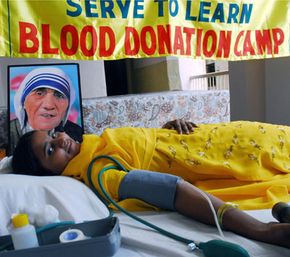Donating Blood and Body
In addition to organs, you can also donate tissue, blood stem cells, blood and platelets, and even your body.
Tissue is composed of layers of cells that function together to serve a specific purpose. It must be donated within 24 hours of death. Some types of tissue donations include:
Advertisement
- Cornea: One of the most commonly transplanted tissues each year (more than 45,000) is the cornea [source: Cigna]. The cornea -- a transparent covering over the eye -- is the eye's primary focusing component. A cornea transplant restores sight to recipients blinded by an accident, infection or disease. Corneas can be transplanted whole or in parts and require no anti-rejection drugs in the recipient [source: Levy]. Corneas from a 75-year-old donor are just as effective as younger corneas.
- Bones: Donated bones can be used to replace cancerous bones in the arm or leg in lieu of amputation.
- Veins: Donated veins are used in cardiac bypass surgery.
- Other donated tissue includes tendons, ligaments, heart valves and cartilage.
Blood stem cells are immature blood cells that can produce more blood-forming stem cells, or mature into white blood cells, red blood cells or platelets. Blood stem cells can be taken from bone marrow, the bloodstream or the umbilical cord. Stem cells within bone marrow -- the spongy tissue inside of bones -- produce blood cells. Donated bone marrow can be infused into the blood stream to fill cavities in depleted bones and resume production of normal blood cells.
The most common donation made is blood and platelets. In addition to donating blood for others, you can also donate blood to yourself before going into surgery. Donated blood (after being screened for disease or abnormalities) is separated by blood type and can be transplanted whole, or separated into plasma, platelets or red blood cells.
You may donate your full body to science (or more precisely, the research institute or university of your choice) by legally inserting the wish to do so in your will. Full body donations are used for training doctors, studying the human body and perfecting forensic research and investigative techniques. In most cases, organs cannot be removed from a body that is to be used for research purposes. At the time of your death, the institute is notified, and a representative will inquire about the cause of death and the state of the body to determine if the donation can be accepted. Funeral ceremonies are often encouraged, but require a slightly different embalming process. Afterward, the body is shipped to the institution.
Getting the right organs to the right person is a complicated process. What organizations help streamline organ donation?
